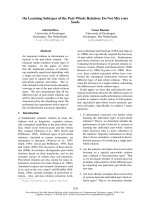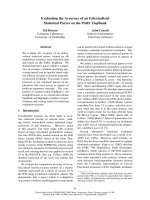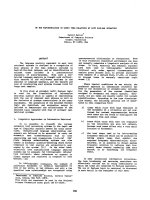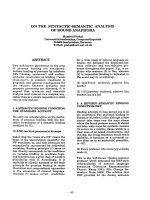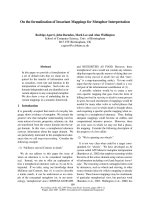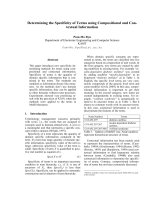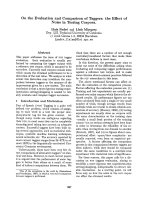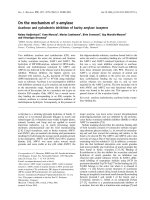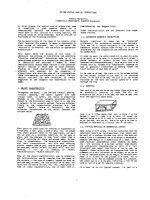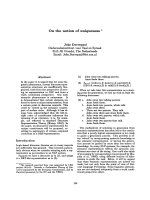Báo cáo khoa học: " On the epidemiology of influenza: reply to Radonovich et al" ppt
Bạn đang xem bản rút gọn của tài liệu. Xem và tải ngay bản đầy đủ của tài liệu tại đây (193.71 KB, 3 trang )
BioMed Central
Page 1 of 3
(page number not for citation purposes)
Virology Journal
Open Access
Commentary
On the epidemiology of influenza: reply to Radonovich et al
John J Cannell*
1
, Michael Zasloff
2
, Cedric F Garland
3
, Robert Scragg
4
and
Edward Giovannucci
5
Address:
1
Department of Psychiatry, Atascadero State Hospital, 10333 El Camino Real, Atascadero, CA 93423, USA,
2
Departments of Surgery and
Pediatrics, Georgetown University, Washington, DC, USA,
3
Department of Family and Preventive Medicine, University of California San Diego,
La Jolla, CA, USA,
4
Department of Epidemiology and Biostatistics, University of Auckland, Auckland, New Zealand and
5
Departments of Nutrition
and Epidemiology, Harvard School of Public Health, Boston, MA, USA
Email: John J Cannell* - ; Michael Zasloff - ; Cedric F Garland - ;
Robert Scragg - ; Edward Giovannucci -
* Corresponding author
Abstract
On the epidemiology of influenza: reply to Radonovich LJ, Martinello RA, Hodgson M, Milton DK,
Nardell EA. Influenza and ultraviolet germicidal irradiation. Virol J. 2008, 5:149
Commentary
To the Editor:
We thank Radonovich et al [1] for commenting on our
paper [2], in which we attempted to use the epidemiology
of vitamin D to clarify the manifold mysteries surround-
ing the epidemiology of influenza. Since our publication,
Ginde et al [3] have produced additional evidence in sup-
port of our theories. They studied the relationship
between 25-hydroxy-vitamin D [25(OH)D] levels and
recent upper respiratory tract infections (URI) in 18,883
participants in the Third National Health and Nutrition
Examination. Compared to individuals with serum 25-
hydroxy-vitamin D levels of > 30 ng/ml, those with levels
< 10 ng/ml had 55% higher odds of a recent URI. Further-
more, very recent evidence indicates 25(OH)D levels of
even 30 ng/ml often signify chronic substrate starvation
[4], thus the full antimicrobial properties of vitamin D
may be understated.
Radonovich et al did not supply any evidence against the
main hypotheses proposed in our paper, only to a specu-
lation we made about ultraviolet germicidal air irradia-
tion. They take factual issue with our theory that the
ultraviolet C radiation (UVC) lamps, used in the past to
sterilize the upper air in some VA hospitals, may have
exerted some, or most, of their effects – not by sanitizing
air – but by increasing 25(OH)D levels.
Radonovich et al assert there was no patient exposure
from UVC germicidal lamps, as they were installed to irra-
diate only the upper air and never shone directly on
patients, thus "minimizing UV exposure in the occupied
space below." Careful inspection of such an arrangement,
in a 1957 Baltimore VA hospital, is illuminating [5]. Pho-
tographs show lights that seemed to shine indirectly on
patients, apparently 24 hours per day, seven days a week.
Depending on the characteristics of the reflective surfaces,
it seems possible – even likely from the photographs –
that a small amount of UVC was reflected downward
toward the patients.
Radonovich et al then assert that even if some UVC
reflected downward, it could not produce Vitamin D, as
UVC radiation does not do so, citing MacLaughlin et al
[6]. The belief that UVC radiation cannot produce vitamin
Published: 11 August 2009
Virology Journal 2009, 6:121 doi:10.1186/1743-422X-6-121
Received: 24 June 2009
Accepted: 11 August 2009
This article is available from: />© 2009 Cannell et al; licensee BioMed Central Ltd.
This is an Open Access article distributed under the terms of the Creative Commons Attribution License ( />),
which permits unrestricted use, distribution, and reproduction in any medium, provided the original work is properly cited.
Virology Journal 2009, 6:121 />Page 2 of 3
(page number not for citation purposes)
D may be a widespread misconception. Fortunately for
humans, as UVC is highly carcinogenic, UVC does not
penetrate the atmosphere and certainly does not trigger
cutaneous Vitamin D during the course of normal human
affairs. However, closer reading of their MacLaughlin et al
reference [6] would have revealed that significant photo-
synthesis of vitamin D from 7-dehydrohydrocholesterol
(7-DHC) occurs at UVC wavelengths in the epidermal lip-
ids the authors extracted [as illustrated in MacLaughlin et
al's figure 1(B)]. Indeed, per photon, UVC photosynthesis
is greater than UVB [as illustrated in MacLaughlin et al's
figure 1(C)].
Furthermore, several animal studies indicate that UVC,
which should never be used in man, is highly effective in
both producing vitamin D and in treating rachitic rats [7].
Knudson and Benford studied numerous UV wavelengths
in rats, finding UVC as effective as any of the UVB wave-
lengths studied in curing rickets [8]. If all human Vitamin
D production is intra-epidermal, the academic question
appears to be, how deep does UVC penetrate human epi-
dermis? Campbell et al found evidence that significant
amounts of UVC penetrate through the stratum corneum,
stratum lucidum, stratum granulosum, and small
amounts of UVC even reach the upper layers of the 7-
DHC-rich stratum spinosum [9]. Thus, UVC penetrates far
enough into the epidermis to trigger some intra-epider-
mal vitamin D production. Again, because UVC is so
mutagenic, we are heartened to find no studies that
directly test this theory in living humans.
However, even if no UVC penetrated the stratum cor-
neum, Helmer and Jensen published a remarkable
human/animal study in 1937, showing that significant
amounts of Vitamin D are made on the surface of human
skin [10]. They collected surface oils from young men,
irradiated the oils, and showed those oils rapidly cured
rachitic rats. Then, they tested a very practical and impor-
tant question, can those oils be removed by washing.
Indeed they found a simple water wash removed much of
the Vitamin D from the surface of human skin. Holick et
al's landmark study showing most human Vitamin D pro-
duction occurs in the deep epidermis was based on surgi-
cally obtained (and assumedly surgically prepped) skin
samples that then had surface oils removed again by
washing in hot water [11]. Indeed, to accurately address
the question, one would need to obtain unwashed human
skin, difficult to do even from cadavers.
It appears to us that the percentage of Vitamin D made on
the surface of the human epidermis, compared to that
made inta-epidermally, is unknown at this time and in
need of additional and careful research. What percentage
of the Vitamin D made in human skin after sun exposure
is removed by simply washing? Furthermore, as the per-
centage made of the surface is significant, studies of cuta-
neous Vitamin D production in modern humans, unless
unwashed, will not give accurate estimates of Vitamin D
production in early man and thus an estimate of the "nat-
ural" 25(OH)D levels present when the human genome
evolved.
We repeat our aside hypothesis that the patients in UVC
irradiated hospitals may have been the beneficiaries of
more than just cleaner air. Much more importantly, influ-
enza is just one of many seasonal infections sensitive to
the broad spectrum anti-microbial peptides (AMP) that
vitamin D up-regulates [2]. Invasive pneumococcal dis-
ease, meningococcal disease, and group A streptococcal
disease are all highly seasonal [12-14] and all are sensitive
to AMP [15-17]. Would vitamin D be an effective adjuvant
in these devastating diseases?
As research into vitamin D's remarkable effects on innate
immunity quickens [18], we hope to see the day when
infectious disease experts use all available antimicrobial
strategies, including testing the serum 25(OH)D level in
all patients with severe infections. In our opinion, physi-
cians treating such patients should vigorously replete
them, quickly achieving 25(OH)D levels in the high range
of normal.
References
1. Radonovich LJ, Martinello RA, Hodgson M, Milton DK, Nardell EA:
Influenza and ultraviolet germicidal irradiation. Virol J 2008,
5:149.
2. Cannell JJ, Zasloff M, Garland CF, Scragg R, Giovannucci E: On the
epidemiology of influenza. Virol J 2008, 5:29.
3. Ginde AA, Mansbach JM, Camargo CA Jr: Association between
serum 25-hydroxyvitamin D level and upper respiratory
tract infection in the Third National Health and Nutrition
Examination Survey. Arch Intern Med 2009, 169(4):384-390.
4. Heaney RP, Armas LA, Shary JR, Bell NH, Binkley N, Hollis BW: 25-
Hydroxylation of vitamin D3: relation to circulating vitamin
D3 under various input conditions. Am J Clin Nutr 2008,
87(6):1738-1742.
5. Riley RL, Wells WF, Mills CC, Nyka W, Mclean RL: Air hygiene in
tuberculosis: quantitative studies of infectivity and control in
a pilot ward. Am Rev Tuberc 1957, 75:420-431.
6. MacLaughlin JA, Anderson RR, Holick MF: Spectral character of
sunlight modulates photosynthesis of previtamin D3 and its
photoisomers in human skin. Science 1982,
216(4549):1001-1003.
7. Bunker JWM, Harris RS, Mosher LM: Relative efficiency of active
wave-lengths of ultraviolet in activation of 7-dehydrocholes-
terol. J Am Chem Soc 1940, 62(3):508-511.
8. Knudson A, Benford F: Quantitative studies of the effectiveness
of ultraviolet radiation of various wavelengths in rickets. J
Biol Chem 1938, 124:287-299.
9. Campbell C, Quinn AG, Angus B, Farr PM, Rees JL: Wavelength
specific patterns of p53 induction in human skin following
exposure to UV radiation. Cancer Res 1993, 53(12):2697-2699.
10. Helmer AC, Jensen CH: Vitamin D precursors removed from
the skin by washing. Studies Inst Divi Thomae 1937, 1:207-216.
11. Holick MF, MacLaughlin JA, Clark MB, Holick SA, Potts JT Jr, Ander-
son RR, Blank IH, Parrish JA, Elias P: Photosynthesis of previtamin
D3 in human skin and the physiologic consequences.
Science
1980, 210(4466):203-205.
12. Dowell SF, Whitney CG, Wright C, Rose CE Jr, Schuchat A: Sea-
sonal patterns of invasive pneumococcal disease. Emerg Infect
Dis 2003, 9(5):573-9.
Publish with BioMed Central and every
scientist can read your work free of charge
"BioMed Central will be the most significant development for
disseminating the results of biomedical research in our lifetime."
Sir Paul Nurse, Cancer Research UK
Your research papers will be:
available free of charge to the entire biomedical community
peer reviewed and published immediately upon acceptance
cited in PubMed and archived on PubMed Central
yours — you keep the copyright
Submit your manuscript here:
/>BioMedcentral
Virology Journal 2009, 6:121 />Page 3 of 3
(page number not for citation purposes)
13. Jensen ES, Lundbye-Christensen S, Pedersen L, Sørensen HT, Schøn-
heyder HC: Seasonal variation in meningococcal disease in
Denmark: relation to age and meningococcal phenotype.
Scand J Infect Dis 2003, 35(4):226-9.
14. Vlaminckx BJ, van Pelt W, Schouls LM, van Silfhout A, Mascini EM,
Elzenaar CP, Fernandes T, Bosman A, Schellekens JF: Long-term
surveillance of invasive group A streptococcal disease in The
Netherlands, 1994–2003. Clin Microbiol Infect 2005,
11(3):226-231.
15. Lee HY, Andalibi A, Webster P, Moon SK, Teufert K, Kang SH, Li JD,
Nagura M, Ganz T, Lim DJ: Antimicrobial activity of innate
immune molecules against Streptococcus pneumoniae,
Moraxella catarrhalis and nontypeable Haemophilus influen-
zae. BMC Infect Dis 2004, 4:12.
16. Bergman P, Johansson L, Wan H, Jones A, Gallo RL, Gudmundsson
GH, Hökfelt T, Jonsson AB, Agerberth B: Induction of the antimi-
crobial peptide CRAMP in the blood-brain barrier and
meninges after meningococcal infection. Infect Immun 2006,
74(12):6982-6991.
17. Ryan MA, Akinbi HT, Serrano AG, Perez-Gil J, Wu H, McCormack
FX, Weaver TE: Antimicrobial activity of native and synthetic
surfactant protein B peptides. J Immunol 2006, 176(1):416-425.
18. White JH: Vitamin D signaling, infectious diseases, and regu-
lation of innate immunity. Infect Immun 2008, 76(9):3837-3843.
